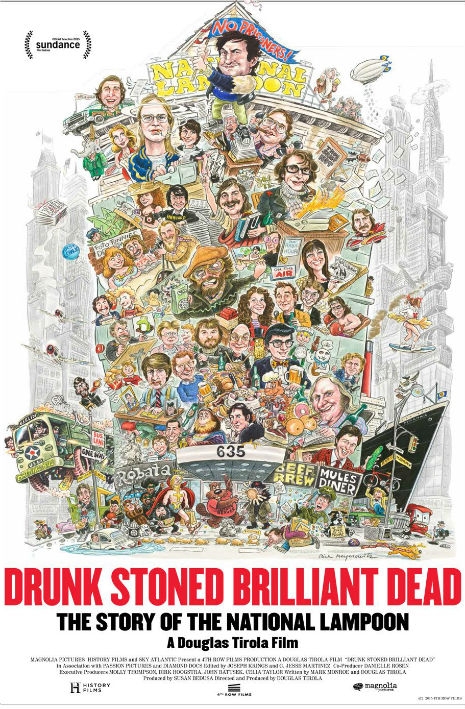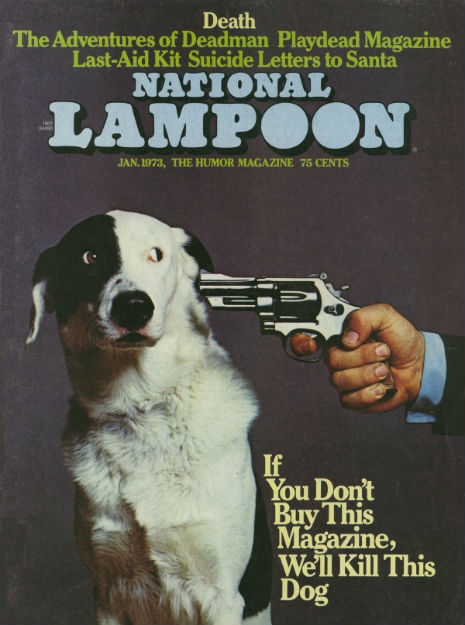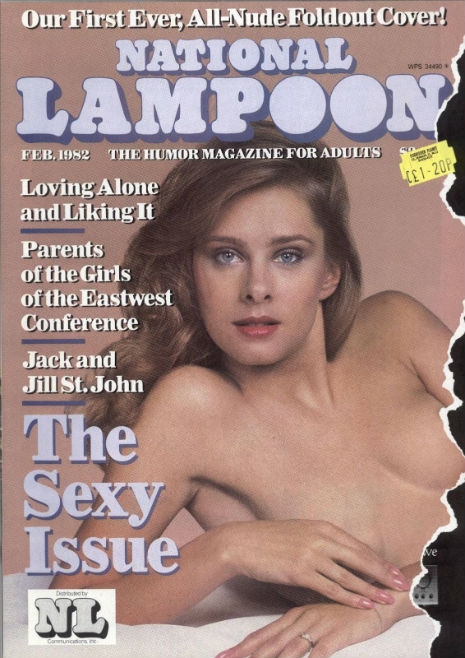
When I was a kid, along with CREEM and Crawdaddy, the National Lampoon was one of the indispensable counter culture magazines. It was simultaneously raunchy, nihilistic, intellectual, dumb and dirty. I loved it and it very often it had NAKED LADIES inside the covers. To my innocent mother’s eyes, the National Lampoon probably looked like MAD magazine. Little did she know…
Dangerous Minds readers have probably noticed our pal Michael Simmons’ occasional guest posts along with his frequent comments here. He was a consultant—and interviewee—in director Douglas Tirola’s new documentary about the Lampoon, Drunk Stoned Brilliant Dead: The Story of the National Lampoon opening wide today in theaters and VOD. Michael grew up Lampoon. His father was the publisher, Matty Simmons. I asked him a few questions over email.
Richard Metzger: As the son of the publisher, you obviously had a ringside seat for the rise of the National Lampoon, which was really one of the defining magazines of the 1970s. When he first told you about the new business he was starting how did you react? Did you perceive your dad as a really hip guy?
Michael Simmons: I was thrilled when he decided to publish the Lampoon — I was 15 when the Lampoon debuted in April 1970. Like many kids of bosses, I worked at “Dad’s store” after school and summers. I was already a self-defined member of “the underground” — what the media called “hippies.” I met the three Harvard guys — Doug Kenney, Henry Beard and Rob Hoffman — sometime in 1969 and immediately hit it off with Doug who was the freakiest of the three and therefore the closest to my sensibilities.
Prior to the Lampoon, Matty had published Cheetah magazine – a slick, smart, high-quality mag that was meant to cater to freaks. It was pubbed around the same time as Rolling Stone—Cheetah went under after less than a year. So while Matty was of a different generation and cultural perspective, Cheetah had loosened him up considerably. Screaming matches about my hair length eventually ceased.
Being the boss’ son has never been the easy ride some may think. Lampoon contributor Anne Beatts claims in the documentary that her boyfriend Michael O’Donoghue quit because Matty “gave” me Anne’s desk in early 1974 – an utterly absurd fallacy. She’s been repeating this canard for 40 years. I was living in upstate New York at the time and didn’t have an office at the Lampoon. Matty was The Chairman Of The Board – not The Chairman Of Desks.
So while “The Boss’ Son” tag could be a drag, I also had adventures I otherwise wouldn’t have been privy to. When I was 19, I was company manager of The National Lampoon Show with John Belushi, Gilda Radner, Bill Murray, Brian Doyle-Murray, Harold Ramis, Joe Flaherty and Paul Jacobs. That was singular — to put it mildly.
What’s “the one thing” about him that you remember the most from around that time?
Michael Simmons: Matty is often portrayed as simply “the business guy,” but it was his idea to do Lemmings, The Radio Hour, The High School Yearbook (including the infamous cover), Animal House, bringing John Hughes to Hollywood, and more. He’s the epitome of the “Idea Man.”

I like how the doc focuses on the brilliant art direction of the magazine. If you look at it year to year, issue to issue, there is an unflagging brilliance there. Michael Gross and David Kaestle were design geniuses, up there with the likes of George Lois and Milton Glaser. I feel they are unfairly neglected in the history of graphic design. Without their input it really wouldn’t have been the same thing, would it?
Michael Simmons: Michael Gross was crucial to the Lampoon’s success. As Gross and others explain in the documentary, he understood that to parody something properly, the parody had to resemble the object being satirized.
Overall, working at the early Lampoon was an extraordinary experience – the smartest, funniest, edgiest writers and artists under one roof. I’ve never experienced anything like it before and I don’t believe I ever will. The generation of the 1960s and ‘70s has been called the most educated. In addition to tits and ass jokes, there were literary references that most young people of The Twenty-Worst Century simply wouldn’t get – text messages having replaced Yeats and Shakespeare.
Any good Michael O’Donoghue stories you’ve heard that have never made it into print or the documentary?
Michael Simmons: I could write a book filled with O’D anecdotes – “colorful” is an understatement. Underneath the rage that animated much of his work was a deep soulfulness. But his temper is correctly recalled as epic. I was his assistant for a couple of years – an interesting gig for a teenager. I had a desk outside his office from which I would do his bidding. One day I heard him telephoning the Columbia Record & Tape Club. Apparently they’d sent him the wrong records. He began screaming and threatened to send them 40 tons of bricks COD – cash on delivery – and listed a slew of other acts of vicious revenge. This escalated to the point that several staffers gathered around Michael’s office. After he slammed the phone down, he peeked out the door of his office with a devilish grin on his face, knowing that this impromptu performance art was partly for our benefit. We applauded.
I brought Michael and Anne to Max’s Kansas City to see this new comic I’d flipped over — Martin Mull. That precipitated several very liquid lunches on the Lampoon dime with O’D and Mull at full throttle. It’s rare that I have that kind of fun these days!

You were in some of the “Foto Funnies,” weren’t you?
Michael Simmons: I was and you can glimpse a young me on the left at 1:43 in a Foto Funny from the early ‘70s seen in the Lampoon documentary trailer.
When I became an editor in 1984, like previous editors I’d write Foto Funnies designed to include myself – one way of guaranteeing the company of naked models.
One of the other exaggerations told about the Lampoon is that it became a skin magazine in the 1980s. It was always a skin magazine to some degree. This increased our popularity among young men as actor Kevin Bacon points out in the documentary. Our circulation jumped when a scantily clad, attractive young woman was on the cover, so it was largely a business decision. We’ve been criticized for overdoing the under-dressed dames by a handful of bitter former employees, but they enjoyed getting a paycheck – so fuck ‘em.
How did Animal House change things in the National Lampoon orbit?
Michael Simmons: Hollywood—and Saturday Night Live – began waving money and many of our best scribes defected to the Hollywood Hills and Rockefeller Center. We became a victim of our own success.
Who owns the National Lampoon trademark today?
It’s a corporation owned by the stockholders. Two guys named Jerry Daigle and Alan Donnes currently run it.
A friend of mine (Jesse Merlin) was in the most recent Lampoon stage show a few years back and he said that he thought Matty was a really good, very dynamic and energetic producer. Is he still at it?
Michael Simmons: He is indeed still at it. My father amazes me. He’s still writing and just wrote the cover story for Reader’s Digest which my brother edits. I hope I have his energy when I’m his age.